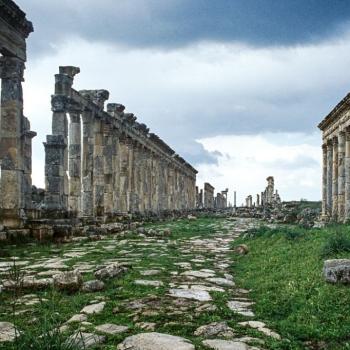I was reading today about Atargatis, the Syrian Goddess, a figure I’ve been intrigued with for a while, and found that, according to some sources, she had a daughter called Semiramis who seemed to be a sorceress or a witch, who was also madly in love with a man, Ara de Handsome of Fair. While not pre-Islamic, it’s a story certainly connected to pre-Islamic mythology, shows how some myths serve more of a political purpose, and also leaves a useful message.
I will write about Atargatis later, but for now, to give some context, she has been told to be the mermaid Goddess of Northern Syria, her main place of worship was at Hierapolis (Britannica, 2013), modern-day Membij, in the Aleppo Governorate, although I find it interesting Aleppo doesn’t have a direct connection to large bodies of water like the Tartus and Latakia Governorates. She has been said to be a motherhood, fertility, love, and protection Goddess, named Derketo by the Greeks, and Dea Syria and Deasura by the Romans. There is also a public domain book about her, De Dea Syria, On the Syrian Goddess, by Lucian of Samosata, that has been somewhat controversial about whether it is historically accurate or not. Lightfoot (2003) has said that, although it has even been questioned if Lucian is indeed the author, he is for sure and this doesn’t compromise the book’s accuracy.
Semiramis, Child of Atargatis

Atargatis supposedly had a daughter, Semiramis, also called Shamiram, usually connected to the Assyrian queen Shammuramat (J. Mark, 2021). Legend has it that she had a daughter with a mortal man, sometimes mentioning it was Caÿstros, a river God from Lydia in Anatolia, modern Turkey, but I haven’t been able to verify this. However, the Goddess felt ashamed of this union, so she abandoned the child in the sea, killed Caÿstros, and drowned herself. (Such Gutiérrez, 2021). Greek historian Diodorus Siculus (c. 90-30 BCE) offers a detailed version of the legend:
Now there is in Syria a city known as Ascalon, and not far from it a large and deshep lake, full of fish. On its shore is a precinct of a famous goddess whom the Syrians call Derceto; and this goddess has the head of a woman but all the rest of her body is that of a fish, the reason being something like this. The story as given by the most learned of the inhabitants of the region is as follows: Aphrodite, being offended with this goddess, inspired in her a violent passion for a certain handsome youth among her votaries; and Derceto gave herself to the Syrian and bore a daughter, but then, filled with shame of her sinful deed, she killed the youth and exposed the child in a rocky desert region, while as for herself, from shame and grief she threw herself into the lake and was changed as to the form of her body into a fish; and it is for this reason that the Syrians to this day abstain from this animal and honour their fish as gods.
Feed and kept warm by doves, the child survived and was discovered by the royal shepherd of the Assyrian King, who adopted her and gave her the name of Semiramis. (Such Gutiérrez, 2021). As she grew up, Semiramis became a beautiful woman who caught the attention of a general, Onnes, who she advised several times, gaining him great success.
Queen Semiramis
The Assyrian king himself, Ninus, fell in love with her for this same reason, offering one of his own daughters to Onnes in exchange for Semiramis, but Onnes refused. The king then threaten Onnes to put out his eyes, causing the general to commit suicide out of fear and love. Thus, Semiramis became queen of Assyria, an empire that covered, in modern terms, northern Iraq, northeast Syria, southeast Turkey, and fringe areas of northwest Iran. Shemiramis acquired a lot of power and gain the respect of many, even after her husband’s death, founded the city of Babylon, but her story had just begun. ( J. Mark, 2021).
It has been noted by many historians that Diodorus’ account of her campaign against India has many similarities to those of Alexander the Great and her conquest of the Medes likewise.
Not wanting to be dominated by another man, she took a series of lovers from the most handsome men in her army. She would sleep with them and have them executed the next morning* or, according to other accounts, buried alive the next day. In all her military excursions, she showed herself brilliantly resourceful (such as creating the fake elephants for her India campaign) and as ruthless as any Assyrian king.
By the end of her reign she ruled all of Anatolia, Mesopotamia, and Central Asia. She died at the age of 62, having ruled for 42 years, and turned into a dove, which flew up into the heavens. Another account, which is alluded to by Diodorus, is that, upon her death, the doves that had helped her in her youth returned and carried her off into the sky.
Semiramis and Ara: The Witch Queen

Basmajian, Ouzounian, Franchuk, and Hacikyan (2000, pp: 35-36) recount a popular story concerning Semiramis in which she falls in love with Armenian hero and King Ara the Handsome, sometimes also called Ara the Fair, and asked him to marry her, but when the hero refused, the queen gathered her army and started a war against Armenia. Despite her instructions to keep Ara alive, the king was slain when she was victorious.
It is said that Semiramis was also a sorceress and tried to bring Ara back to life by asking the Gods to lick his wounds, but with no success. She then buried the body, dressed one of her servants as Ara, and spread the rumor that he was alive thanks to the Gods, thus putting an end to the war and glorifying the Gods by constructing a statue in their honor. Finally, the son of Ara was given the same name as his father by the Queen in honor to him and given the throne of Armenia (University of Minnesota, 1918, pp: 10-11).
Other versions (Chahin, 2001, pp: 74) tell that Samiramis was heard by Aralez, Armenian dog-like spirits who brought Ara back to life. Also, like Chahin mentions (2001, pp: 74), I find it interesting that the name Aralez would mean “to lick blood”.
Although her story is filled with madness, obsession, and unhealthy love, along with some ego problems, I see Semiramis as a symbol of strategy and power. As the daughter of Atargatis, who has been compared to Aphrodite, Venus, Ishtar, Astarte, she is also related to love, war, wisdom, and madness. According to Chahin, she would also be a witch, which wouldn’t be surprising considering her parents, no matter if her father was human or not, capable of communicating with spirits of healing, life, and death. All these associations would make Semiramis not only a strategist and cunning Queen, but also a powerful ancestor for Iraqi, Syrian, Turkish, and Iranian witches.
I see her story with King Ara as one that shows that madness and love can become powerful tools for witches, along with teaching that sometimes history repeats itself: just like Atargatis killed her consort due her madness, Semiramis killed Ara for the same reason. It could be possible, though, that Diodorus Siculus wrote the beginning of the myth as a way to show Syria as a less powerful country when compared to Greece. This could be the same case when Semiramis tries to bring Ara back to life: she could well be being portrayed as an infidel to the faith maddened by obsession, or a powerful witch who must be exterminated.
Either way, her story offers an important message: obsession, madness, psychosis, and the like, are double-edged swords, risky tools for the witch. I was speaking with a friend some days ago about Bacchus, and he told me how disturbing it is for him to see how madness is seen nowadays as “all fun and games”, to use his own words. When I told him that maybe most people would be focusing on freedom and shamelessness, he told me those are indeed part of madness, but not the only ones. I couldn’t not agree with him.
In the end, she is the daughter of a Goddess, so, far from thinking of Semiramis as incapable of rising the dead, I think the most significant aspect is that she dared to use the most uncontrollable aspect of herself as fuel for her power. I don’t see a reason, besides the political implications, of her not being able to do it. We’re speaking either about a semi-Goddess or a lesser Goddess, a heroine whose beauty drove men crazy since she became an adult. In this way, she is also a feminist symbol of rebellion, power, and independence.
References:
Basmajian, G., Ouzounian, N., Franchuk, E. S., Hacikyan, A. J. (2000). The Heritage of Armenian Literature: From the oral tradition to the Golden Age. United States: Wayne State University Press. Free preview.
Britannica, T. Editors of Encyclopaedia (2013, June 10). Hierapolis. Encyclopedia Britannica.
Chahin, M. (2001). The Kingdom of Armenia: A History. United Kingdom: Curzon. Free preview.
J. Mark, J. (2021). Sammu-Ramat and Semiramis: The Inspiration and the Myth. World History Encyclopedia.
Lightfoot, J.L. 2003. Lucian On the Syrian Goddess: Edited with Introduction, Translation and Commentary. Oxford: Oxford University Press.
Such Gutiérrez, M., 2021. La véritable histoire de Sémiramis, la légendaire reine assyrienne. National Geographic.
The University of Minnesota. 2016. Studies in the Social Sciences, Issues 13-14 (1918). United States: University of Minnesota. Free ebook version.
* I cannot help but find this particularly similar to the Arabian Nights main story, where King Shahryār takes a different bride every night, sleeps with her, and kills her the next morning.


















